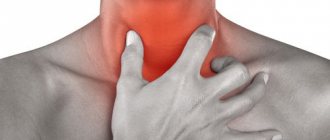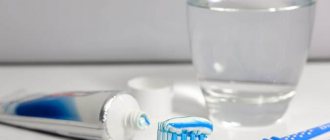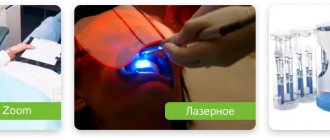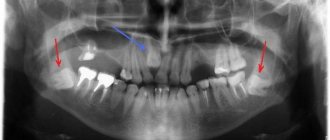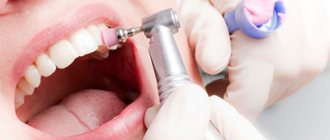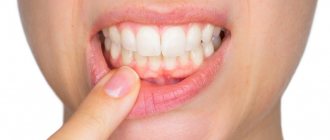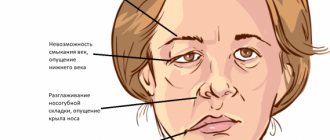Diagnosing the problem at home
Sometimes, to understand which tooth hurts, it is enough to look into your mouth. You need to go to the mirror and conduct a visual inspection. The diseased element may be damaged, with dark spots and depressions. There are also signs that indicate a problem: chipped, worn, cracked or transparent enamel, the presence of pustules and seals on the mucous membrane, inflamed, swollen or bleeding gums.
It also happens that a visual inspection reveals nothing. For example, when the problem develops under an artificial crown or filling. In this case, light pressure on the crowns or gently tapping them with the tip of a teaspoon will help determine the source of the pain.
How else can you find out which tooth hurts? During eating, pieces of food can become lodged in an element destroyed by dental diseases; it is difficult not to feel it. Hard tissues in the area of the pathological process can react to food temperature and mechanical stress during hygiene procedures.
On a note! If you want to understand which tooth hurts, then take the diagnostic question seriously. Before examination, remove soft plaque and food debris from your mouth. The room where the inspection is being carried out should have good lighting. Carefully examine every visible surface of the tooth using a mirror, and also check your gums for inflammation.
Pain in teeth due to diagnosis of other diseases
In some cases, it may seem that a seemingly healthy tooth hurts, but the real reason is the development of pathologies of adjacent organs. Among them are otitis media, inflammation of the hearing organs, sinusitis, pathology in the paranasal sinuses, angina pectoris, osteochondrosis, and damage to the cervical vertebrae. Experts also identify salivary stones, which can be accompanied by swelling and discomfort.
We determine the cause of pain by the nature of the sensations and accompanying symptoms
In most cases, checking which tooth hurts on your own is not difficult. It is more difficult to establish why the discomfort and discomfort appeared. It all depends on the accompanying symptoms.
| Possible reason | Associated symptoms |
| Increased sensitivity of enamel | Thin, transparent enamel, with cracks and chips. Reaction to cold and hot, sour, sweet. Discomfort due to mechanical impact. Often pain occurs not in one, but in several teeth at once or along an entire row |
| Caries | Reaction to food temperature and mechanical stress. The discomfort goes away almost immediately after the irritating factor is eliminated, but as the disease progresses, the pain persists longer. First, white chalky spots appear on the enamel, then black dots, depressions and pits into which food easily gets clogged. |
| Pulpitis | The pain is acute and prolonged, persists for a long time after the removal of the stimulus, can occur involuntarily, and “spread” to all parts of the face and head. Unpleasant sensations intensify at night. With pulpitis, the enamel of the diseased tooth may darken |
| Periodontitis | May occur under a filling or crown. Sharp pain appears when pressing or chewing solid food. With this disease, there is a feeling of fullness and pressure in the inflamed area. The root of the diseased unit may begin to wobble |
| Flux, abscess, cyst | The gums around the diseased element become inflamed, and ulcers, pimples, and lumps may appear on the mucous membrane. In acute and advanced stages, swelling of the soft tissues of the face occurs. Unpleasant sensations intensify during tapping and pressure on the sore area |
| Fistula | An ulcer or pimple on the gum that may ooze fluid or pus. Unpleasant taste and odor in the mouth |
| Root fracture, crack, trauma | Sharp and acute pain, the tooth becomes mobile, it is impossible to chew food on it |
| Periodontal inflammation | If it is not clear which tooth hurts, then it may not be about the tooth at all, but about the periodontal tissues. So, with gingivitis or periodontitis, the mucous membrane itches and becomes inflamed, and also bleeds, and this process is most often generalized (applies to the entire jaw). At advanced stages of periodontitis, the roots become exposed and the teeth become mobile and begin to respond to thermal and mechanical stress. |
| Previously performed poor-quality treatment | If you just recently visited the dentist, and after that the treated tooth began to ache, then in the first 2-4 days this situation can be considered normal. In most cases, this indicates a tissue reaction to various medications and surgical intervention. With each subsequent day, the discomfort should decrease, but if it becomes stronger, this may indicate medical errors made during treatment. |
“I don’t advise anyone to guess on the coffee grounds and independently identify various diseases. In general, I never know which tooth hurts me, because the sensations are always ambiguous. The other day, there was a situation: my upper jaw was aching, and I was sure that the problem was there, although visually everything was normal everywhere. Even when I went to the doctor, I indicated a specific area, but the dentist looked and said that this was not so. As a result, the lower filled molar turned out to be problematic, under which secondary caries developed, and it was treated.”
Katerina, review from the dental portal gidpozubam.ru
A healthy tooth hurts: common causes
- Increased sensitivity. Any even minor impact, such as pressure, can cause pain in a healthy tooth. In this case, it is recommended to perform remineralization and treatment using special compounds containing fluorine and calcium.
- Formation of chips and cracks. The cause of the unpleasant sensation can be microscopic, invisible damage to the enamel. It is recommended to consult a doctor for diagnosis and required therapeutic intervention.
- Damage to gums. It can result in increased bleeding and inflammatory reactions, which can cause pain in a healthy tooth. Rinsing with a water-salt composition in accordance with the opinion of the dentist will solve this problem.
- Periodontitis. Inflammation in the dentin area. This disease may be accompanied by a general deterioration of the condition and requires immediate dental intervention.
- Extraction of nerve tissue. After a complex procedure, unpleasant sensations may be recorded. The cause may be unskilled intervention, poor-quality treatment of the canals with special aseptic preparations.
- Pulpitis. Complication of caries. If treatment is delayed, an element of the dentition may be lost; you need to visit a doctor as soon as possible.
In most cases, a healthy tooth may hurt due to increased sensitivity. Pain is especially noticeable after eating something sweet, hot or cold. It should be noted that in some cases this may cause damage to the soft or hard tissues of the dental system.
For prevention, you need to brush the elements of the dentition for two minutes or more. To achieve results, at least 35 brushing strokes are required, and it is recommended to use a soft brush. In addition, it is necessary to choose the right paste. Bleaching compounds can enhance the abrasion process of soft tissues.
Pain syndrome can also occur due to overload of the incisor or due to the development of hidden pathological processes. These include damage to hard tissues, tooth root fracture and other negative phenomena. In addition, malocclusion can also become a source of discomfort.
In the arsenal of modern specialists there is a whole range of diagnostic tools with which he can conduct an examination and determine why a healthy tooth is loose or the patient is experiencing discomfort. An X-ray or computed tomography will help diagnose the pathology. This will allow you to choose the right method of therapeutic intervention.
The whole jaw aches: what does this mean?
Many patients, when visiting a doctor, complain that their entire jaw ache, but after examination it turns out that one tooth is to blame. Why is this happening? With some pathologies, pain can radiate (give) to different parts of the face and head: jaw, temple, ear, eyes. This often happens with pulpitis, eruption of wisdom teeth, the presence of impacted and dystopic elements in the jawbone that grow in the wrong direction, put pressure on their neighbors or do not break out at all. Pain can radiate to different areas if the disease is in an acute stage or the patient has advanced pathology.
On a note! Does your entire jaw ache after tooth extraction? This situation is also not uncommon, especially if the extraction was difficult and traumatic, or occurred against the background of a cyst or abscess. To ensure that the discomfort quickly disappears, strictly follow all the doctor’s recommendations. If improvements do not occur after 5-7 days, and alarming signs intensify, then contact your dentist immediately.
The entire jaw may ache if the patient has a malocclusion, since against the background of this problem the maxillofacial apparatus or its individual areas are overloaded, and teeth wear out, wear out and are destroyed ahead of schedule. Discomfortable sensations radiating throughout the entire jaw can also occur during bite correction with orthodontic devices, but many patients admit that these are temporary difficulties, because after a period of adaptation to braces or trainers, the situation normalizes.
A healthy tooth hurts, what should I do?
- Preventive actions. To relieve pain, use water-soda solutions or sage decoction. However, even before carrying out such measures, you should consult a doctor so as not to aggravate the situation and subsequently cause a healthy tooth to fall out.
- Therapeutic intervention. The dentist, after diagnosing and identifying the pathology, will prescribe appropriate treatment. In some cases, remineralization may be used, in others, the installation of a filling composition or resection of the root apex of an element of the dentition.
Never be afraid to consult a specialist. Timely intervention will help determine why healthy teeth hurt and avoid further development of pathologies.
If teeth have nothing to do with it
Sometimes it is not clear which tooth hurts. It may even seem like everything hurts at once. But dental disease is not always the cause. Similar symptoms may indicate other problems:
- inflammation of the trigeminal nerve,
- cancerous tumors in the oral cavity,
- ENT diseases: sinusitis, sinusitis, otitis media,
- hypothermia,
- salivary stone disease,
- dysfunction of the temporal mandibular joint,
- pathologies of the cardiovascular system: for example, angina pectoris,
- intervertebral hernia, pinched cervical nerve,
- psychosomatic state of a person: it may simply seem to you that your teeth are aching, especially if you have recently suffered stress,
- Jaw Fracture: Discomfort may occur even years after you have been treated. Some people note that in this way the body and the bones that have grown together after injury react to changing weather.
It is important to understand that internal diseases of the body can aggravate dental problems or contribute to their occurrence, just as, conversely, diseased teeth can cause other pathologies, such as sinusitis. This occurs due to the fact that infections from the source of inflammation can freely penetrate into all adjacent areas.
Causes of bad breath with healthy teeth
Regular visits to the dentist, complete elimination of possible pathologies and careful hygiene are important components in maintaining healthy and beautiful elements of the dentition. However, even if all recommendations are followed and correct therapeutic intervention is performed, an unpleasant odor may still be observed.
Experts identify two main reasons. The first is xerostomia - insufficient salivation, increased dryness. The second is the activation of microorganisms that release harmful compounds. In addition, various internal diseases can become a source of bad breath. There are the following types of odors and their causes:
- The smell of rot. Insufficient production of saliva, abscesses, inflammatory processes in the respiratory organs, plaque on elements of the dentition due to poor quality care.
- Sour smell. Fixed with gingivitis, increased acidity of the gastrointestinal tract, uncontrolled drug intervention. May occur due to hormonal imbalance.
- Musty smell. Most often observed with low production of digestive fluid, biliary dyskinesia or chronic cholecystitis and other pathologies.
Each organism is individual in itself. Much depends on proper metabolism and the possible presence of current chronic diseases. Thorough oral hygiene after every meal and regular visits to the dentist will help keep your dental system in perfect condition.
Methods for diagnosing problems in dentistry
Regardless of whether it is clear or unclear to you which tooth hurts, the first thing to do when an alarming symptom occurs is, of course, to consult a doctor. The specialist will not only accurately diagnose, but also cure the disease that caused the problem. Otherwise, after a short period of time you will notice that not just one, but several nearby units are aching, as the infection has spread further.
Today in dentistry there are many diagnostic methods, one of the informative ones is x-ray examination. To determine the condition of the entire jaw system, roots, root canals and bone tissue, as well as to identify hidden problems, for example, fractures and cracks of the root, cysts and granulomas, the presence of dystopic and impacted teeth, doctors prescribe a two-dimensional panoramic image of the jaw or CT (computed tomography) . The second type of examination - computed tomography - is more accurate, as it allows you to obtain three-dimensional 3D images and examine all processes in great detail.
In addition to X-rays, the doctor will definitely conduct a visual examination using a mirror, percussion1 (tapping on the crown) and examination of the oral cavity using special instruments (dental probe). Additionally, electroodontodiagnosis may be prescribed to determine the viability of the pulp, color and thermal tests to identify various non-carious (hypoplasia, wedge-shaped defect) and carious pathologies.
Diagnosis and treatment
If a tooth aches without signs of caries, contact a dental clinic. Only a specialist can exclude the possibility of carious lesions and make an accurate diagnosis. Typically, diagnosis includes examination and x-rays.
The treatment regimen is drawn up taking into account the clinical picture. Treatment may be directed:
- for remineralization of enamel,
- elimination of factors that provoke pain,
- restoration of the integrity of the dental unit,
- decreased tooth sensitivity,
- strengthening gums and eliminating inflammation.
The doctor will provide more detailed information about treatment during the consultation.
Examination by a doctor
If it is not clear which tooth is causing the pain, it is best to consult a dentist. It is much easier for a doctor to diagnose. He uses his professional knowledge during the inspection. The dentist performs a palpation procedure. Additionally, in this way it is possible to determine whether tooth mobility has appeared.
A professional can identify a diseased tooth by tapping metal or applying heat to the gum.
Visual examination and palpation sometimes does not help to establish an accurate diagnosis. Many dentists use a safer method - a visiograph. This is an innovative, high-precision equipment that allows you to reduce the procedure time when taking images due to the absence of an intermediate step in developing the film, and reduce the level of radiation exposure.
The source of pain can be determined using a CT scan, a targeted or panoramic image. The doctor recommends the option that is best suited in this situation.
Using an X-ray, you can see the condition of the canals, whether there are cysts near the tooth root, or defects in the cervical area. Additionally, the image can show a wisdom tooth if it is just starting to grow and causes pain.
The best option is a panoramic shot. Some dental offices do it right on the spot.
If the dentist sees no reason
It happens that a tooth hurts, but the doctor says that everything is fine. Sometimes the entire jaw can ache due to stress. The pain is aching, and it is impossible to determine which tooth is manifesting itself. This often occurs among people who cannot express their opinion or, in the event of a conflict, very often try to remain silent. We are talking about psychosomatics.
In this case, the doctor will not be able to determine the cause either during the examination or after the x-ray. You need to contact a neurologist.
Sometimes pain can be a consequence of a jaw fracture. Even when the jaw is completely healed, it can still react to changes in the weather. Such pain goes away on its own after a few days.
What types of this pathology exist?
Depending on the origin, the classification of periodontitis includes:
- an infectious form that develops mainly as a complication of caries, and then pulpitis;
- traumatic periodontitis is a consequence of a strong external impact on the tooth with its damage.
According to the type of clinical course, pathology is divided into:
1. Acute form with rapid development of symptoms. It, in turn, is divided into a serous subtype - with periodically changing pain intensity; and purulent - with purulent discharge, constant severe pain, tooth mobility and a high risk of irreversible loss.
2. Chronic periodontitis of the tooth, which progresses rather slowly and sometimes has no clinical manifestations at all. This form of the disease is divided into three subtypes:
- fibrous variant - the initial stage of the disease, which is often detected by chance - on radiography for other reasons;
- granulating periodontitis - the next stage with swelling of the soft tissues of the gums, the appearance of purulent discharge, as well as constant pain;
- granulomatous periodontitis, in which purulent cysts are already formed in the thickness of the gum tissue, requiring immediate surgical removal.
The types of the disease are also divided according to the location of the inflammatory process. If the apex of the tooth root is affected, it is apical periodontitis, which in most cases becomes a complication of pulpitis. And when periodontal inflammation occurs in other parts of the tooth, a marginal form develops - its appearance is most often caused by injuries.


